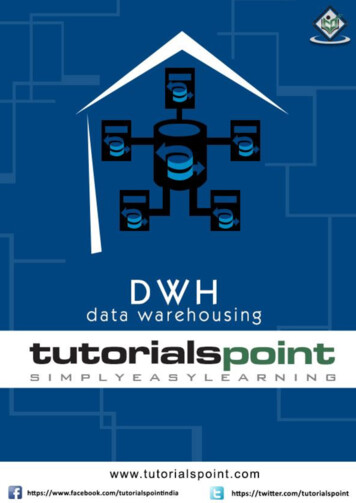
Transcription
Six SigmaAbout the TutorialSix Sigma is a methodology for pursuing continuous improvement in customer satisfactionand profit. It is a management philosophy attempting to improve effectiveness and efficiency.In this tutorial, you will learn what Six Sigma is and how to use Six Sigma in an organization.AudienceThis tutorial has been prepared for the beginners to help them understand the basicfunctionality of Six Sigma.PrerequisitesWe assume the readers of this tutorial have prior exposure to Quality Control and QualityAssurance and related terminologies.Copyright & Disclaimer Copyright 2018 by Tutorials Point (I) Pvt. Ltd.All the content and graphics published in this e-book are the property of Tutorials Point (I)Pvt. Ltd. The user of this e-book is prohibited to reuse, retain, copy, distribute or republishany contents or a part of contents of this e-book in any manner without written consent ofthe publisher.We strive to update the contents of our website and tutorials as timely and as precisely aspossible, however, the contents may contain inaccuracies or errors. Tutorials Point (I) Pvt.Ltd. provides no guarantee regarding the accuracy, timeliness or completeness of our websiteor its contents including this tutorial. If you discover any errors on our website or in thistutorial, please notify us at contact@tutorialspoint.comi
Six SigmaTable of ContentsAbout the Tutorial . iAudience . iPrerequisites . iCopyright & Disclaimer . iTable of Contents . ii1. SIX SIGMA – INTRODUCTION . 1Features of Six Sigma . 1Key Concepts of Six Sigma . 1Myths about Six Sigma . 1Benefits of Six Sigma . 2Origin of Six Sigma . 22. SIX SIGMA – KEY ELEMENTS . 3The Customers . 3The Processes . 3The Employees . 33. SIX SIGMA – ORGANIZATION . 4Leadership . 4Sponsor . 4Implementation Leader . 4Coach . 4Team Leader . 5Team Member . 5Process Owner . 5Extended Definitions of Roles – Belt Colors . 54. SIX SIGMA – GET STARTED . 6ii
Six SigmaIs Six Sigma Right for You? . 6The Cost of Six Sigma Implementation . 6Six Sigma Start-up . 6Project Selection for Six Sigma . 75. SIX SIGMA – METHODOLOGY . 8DMAIC Methodology . 8DMADV Methodology . 8DFSS Methodology . 86. SIX SIGMA – DEFINE PHASE . 10Project Team Formation . 10Document Customers Core Business Processes . 10Develop a Project Charter . 10Develop the SIPOC Process Map . 10Conclusion . 117. SIX SIGMA – MEASURE PHASE. 12Data Collection Plan and Data Collection . 12Data Evaluation . 12Failure Mode and Effects Analysis - FMEA. 13Yield to Sigma Conversion Table . 138. SIX SIGMA – ANALYZE PHASE . 17Source Analysis . 17Process Analysis . 17Data Analysis . 17Resource Analysis . 17Communication Analysis . 18Conclusion . 18iii
Six Sigma9. SIX SIGMA – IMPROVE PHASE . 1910. SIX SIGMA – CONTROL PHASE . 20Quality Control . 20Standardization. 20Control Methods and Alternatives . 20Responding when Defects Occur . 20Conclusion . 2111. SIX SIGMA – TECHNICAL TOOLS. 22Tool #1 – The Critical to Quality (CTQ) Tree . 22Tool #2 – The Process Map . 22Tool #3 – The Histogram . 22Tool #4 – The Pareto Chart . 22Tool #5 – The Process Summary Worksheet . 23Tool #6 – The Cause-Effect Diagram . 23Tool #7 – The Scatter Diagram . 23Tool #8 – The Affinity Diagram . 23Tool #9 – The Run Chart . 23Tool #10 – The Control Chart. 24Conclusion . 2412. SIX SIGMA – DEFECT METRICS. 25Defects Per Unit – DPU . 25Total Opportunities – TO. 25Defects Per Opportunity – DPO . 25Defects Per Million Opportunities – DPMO . 25How to Find Your Sigma Level . 25Simplified Sigma Conversion Table . 26iv
Six Sigma13. SIX SIGMA – SUMMARY. 2714. SIX SIGMA – GLOSSARY . 28v
1. SIX SIGMA – INTRODUCTIONSix SigmaSix Sigma is a highly disciplined process that helps us focus on developing and deliveringnear-perfect products and services.Features of Six Sigma Six Sigma's aim is to eliminate waste and inefficiency, thereby increasing customersatisfaction by delivering what the customer is expecting.Six Sigma follows a structured methodology, and has defined roles for theparticipants.Six Sigma is a data driven methodology, and requires accurate data collection forthe processes being analyzed.Six Sigma is about putting results on Financial Statements.Six Sigma is a business-
Six Sigma is a data driven methodology, and requires accurate data collection for the processes being analyzed. Six Sigma is about putting results on Financial Statements. Six Sigma is a business-driven, multi-dimensional structured approach for: o Improving Processes o Lowering Defects o Reducing process variabilityFile Size: 729KBPage Count: 17











